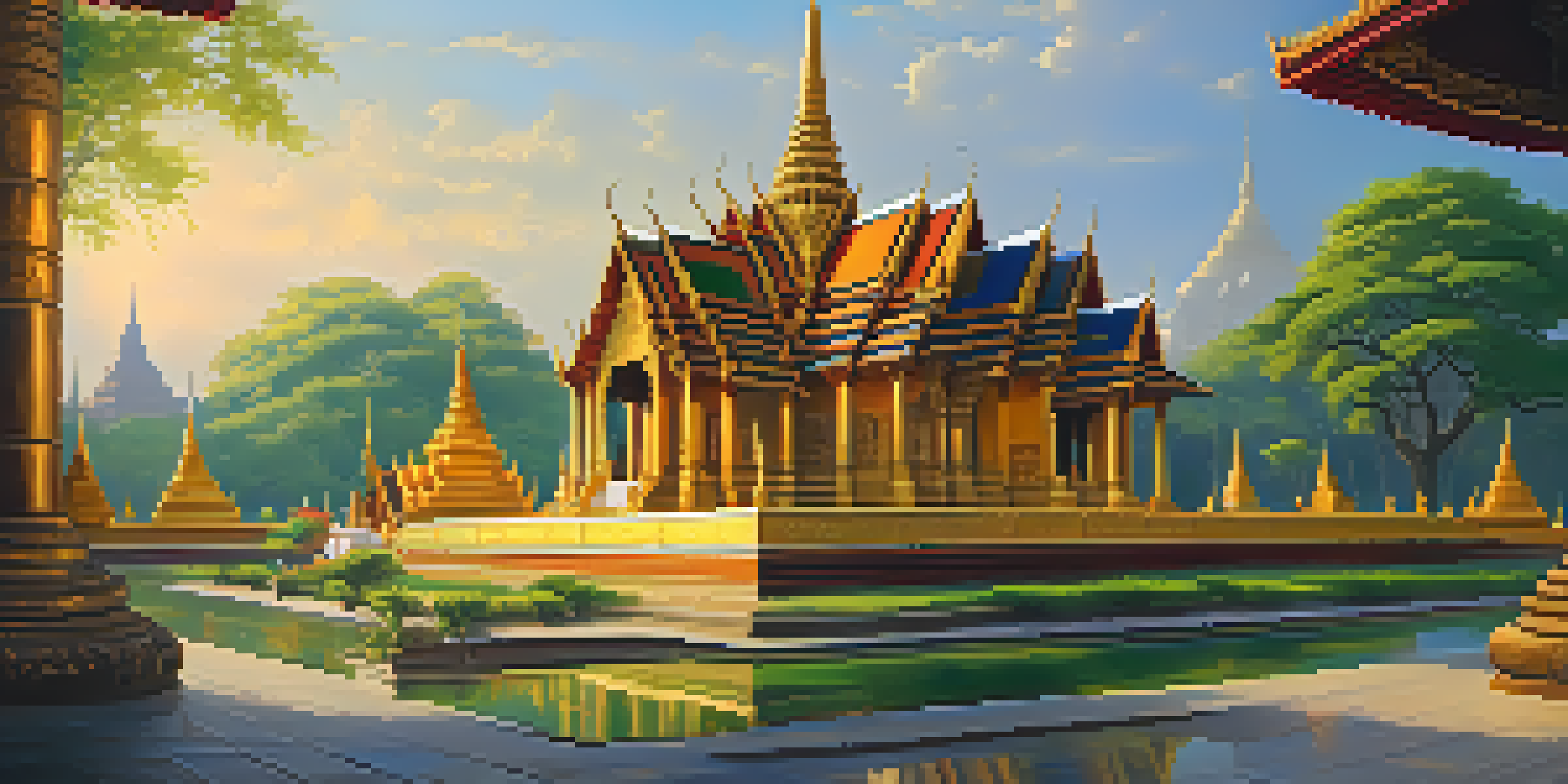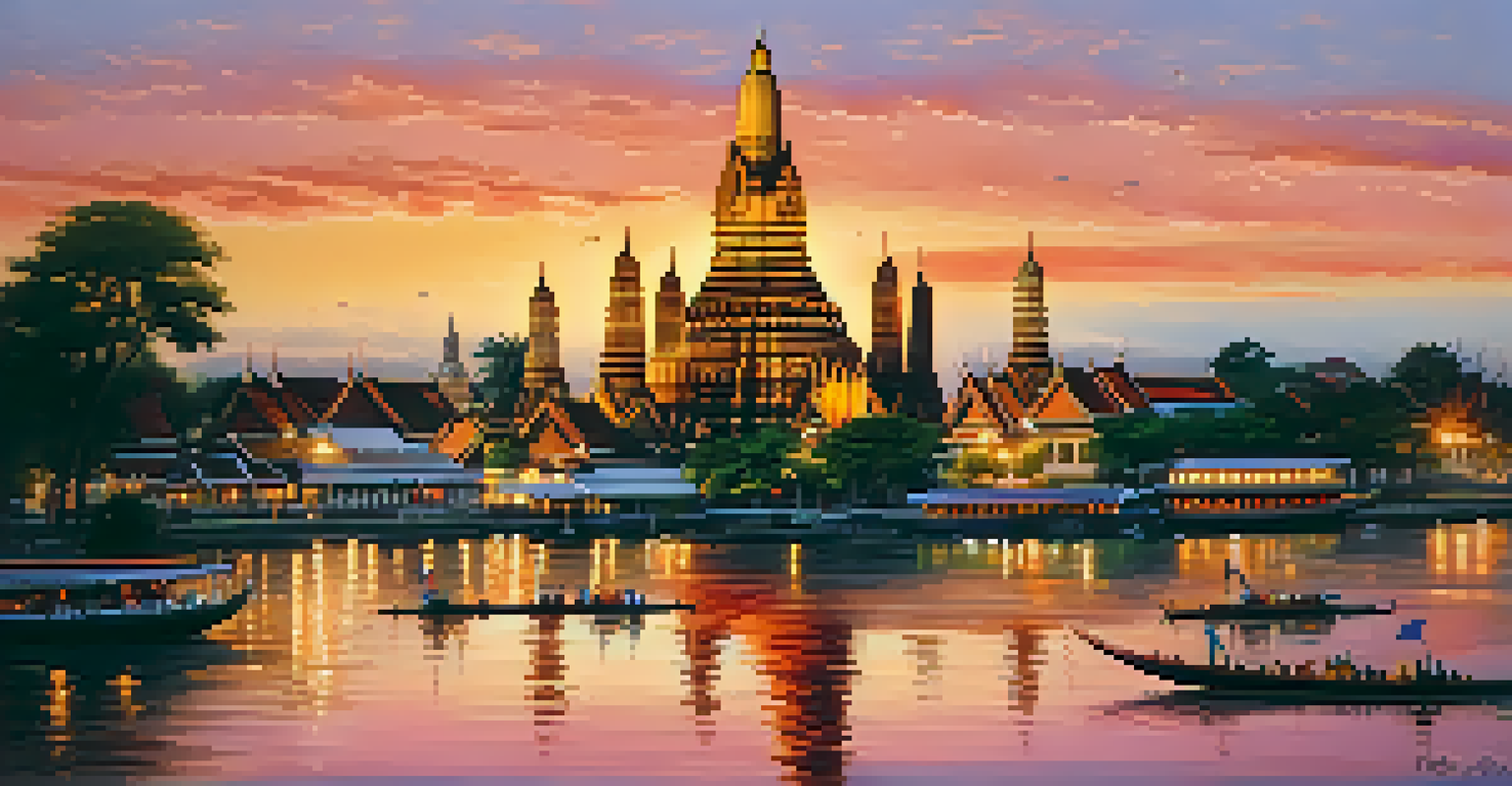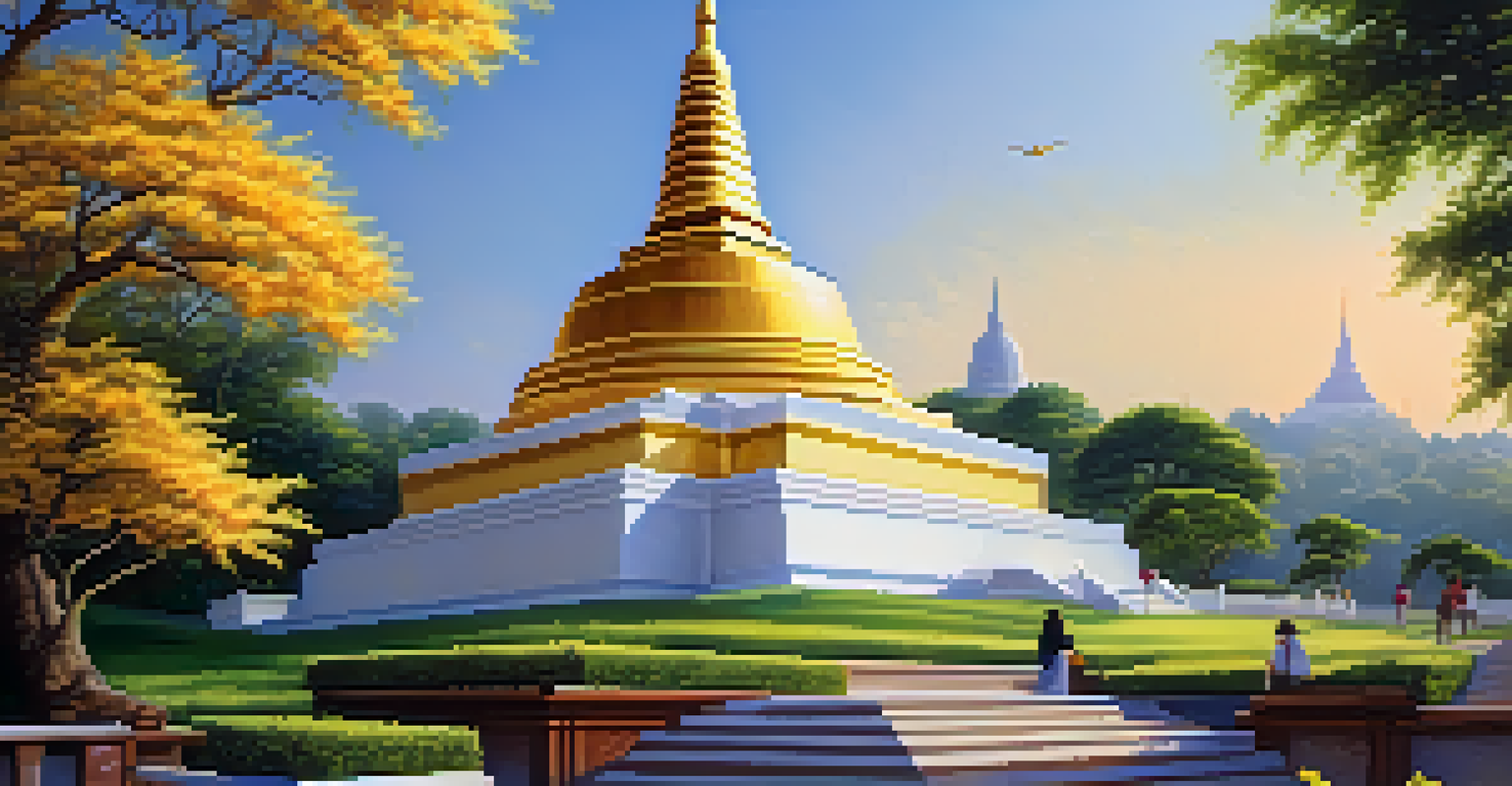Top 10 Temples to Visit for Understanding Thai Buddhism

Wat Phra Kaew: The Jewel of Bangkok's Temples
Wat Phra Kaew, or the Temple of the Emerald Buddha, is often considered the most important temple in Thailand. Located within the grounds of the Grand Palace, it houses a revered statue of Buddha carved from a single piece of jade. This temple is not just a religious site; it's also a symbol of Thai royalty and cultural identity.
The temple is a place where the heart of Buddhism meets the beauty of art.
Visitors are often captivated by the stunning architecture, featuring intricate details and vibrant colors that reflect traditional Thai artistic styles. As you explore the temple, you'll notice the harmony of spirituality and artistry that defines Thai Buddhism. Don't forget to dress respectfully, as proper attire is required to enter this sacred space.
The temple also serves as a great spot to learn about Buddhist rituals and practices. Witnessing local worshippers and their devotion can provide a profound understanding of the faith and its significance in Thai culture. Overall, Wat Phra Kaew is an essential stop for anyone interested in Thai Buddhism.
Wat Pho: Home of the Reclining Buddha
Wat Pho, known as the Temple of the Reclining Buddha, is famous for its enormous statue that measures 46 meters long. This impressive Buddha is covered in gold leaf and positioned in a way that symbolizes the Buddha's entry into Nirvana. The temple is a must-visit for anyone looking to understand Buddhist teachings and Thai history.

Beyond the Reclining Buddha, Wat Pho is also home to numerous smaller Buddha statues and intricate murals that depict scenes from Buddhist lore. As you stroll through the temple grounds, you can witness the serene atmosphere that encourages reflection and meditation. This temple is also recognized as a center for traditional Thai massage, offering visitors a unique cultural experience.
Wat Phra Kaew: Cultural Significance
Wat Phra Kaew is not only a religious site but also a symbol of Thai royalty and cultural identity.
Wat Pho's significance extends beyond its physical beauty; it’s a place where you can connect with the heart of Thai Buddhism. The temple offers guided tours that provide insights into the teachings of Buddhism and the philosophy of mindfulness. It's a peaceful place to soak in the culture and spirituality that Thailand has to offer.
Wat Arun: A Stunning Riverside Temple
Wat Arun, or the Temple of Dawn, is perhaps one of the most iconic temples in Thailand, known for its stunning riverside location and intricate design. The temple's central prang, or tower, stands tall at 70 meters and is beautifully decorated with colorful porcelain. Visiting during sunrise or sunset offers a breathtaking view of the temple illuminated by the golden sun.
In the heart of every temple, there lies a story waiting to be discovered.
This temple has deep historical significance, as it served as the royal temple during the reign of King Rama II. The architecture reflects a blend of Khmer influence and traditional Thai styles, giving it a unique character. Climbing the steep steps to the top of the prang rewards visitors with panoramic views of the Chao Phraya River and the city.
Wat Arun is a perfect example of how Thai Buddhism is intertwined with nature and beauty. As you explore the temple, you can enjoy the peaceful ambiance and reflect on the teachings of the Buddha. It’s a place that inspires both awe and contemplation, making it a must-visit for understanding Thai Buddhist culture.
Wat Saket: The Golden Mount Experience
Wat Saket, known as the Golden Mount, offers a unique perspective on Thai Buddhism with its hilltop location. Climbing the 300 steps to reach the temple rewards visitors with stunning views of Bangkok. The temple's golden stupa gleams in the sun, symbolizing the Buddha's teachings and enlightenment.
The temple dates back to the Ayutthaya period and has undergone several renovations over the years. It's a serene escape from the bustling city, where you can find peace and reflection amidst the lush gardens and fragrant flowers. The atmosphere is particularly tranquil during the early morning or late afternoon.
Wat Pho: A Hub for Learning
Wat Pho serves as a center for understanding Buddhist teachings and offers a unique cultural experience with traditional Thai massage.
Wat Saket is also famous for its annual Loy Krathong festival, where thousands of candles illuminate the temple grounds. This celebration highlights the significance of water in Buddhism and the importance of gratitude. Visiting Wat Saket not only offers a chance to appreciate the beauty of the temple but also to understand the deep traditions of Thai Buddhism.
Wat Ratchabophit: A Hidden Gem in Bangkok
Wat Ratchabophit is a lesser-known temple that offers a more intimate experience with Thai Buddhism. Its unique architectural style combines traditional Thai and Western influences, creating a distinctive atmosphere. The temple is often quieter than the more famous sites, making it an ideal spot for reflection and meditation.
The intricate details of the temple's decorations and the serene gardens invite visitors to explore at their leisure. As you wander through the grounds, you can appreciate the craftsmanship involved in creating this sacred space. The temple also features a stunning ordination hall that showcases beautiful murals depicting Buddhist stories.
Visiting Wat Ratchabophit allows for a deeper understanding of the local practices and rituals associated with Thai Buddhism. Engaging with the monks and locals can provide unique insights into their daily lives and devotion. This hidden gem is a perfect example of how spirituality and art coexist in Thailand.
Wat Phra That Doi Suthep: A Pilgrimage Site
Located on Doi Suthep mountain, Wat Phra That Doi Suthep is a significant pilgrimage site for Thai Buddhists. The temple is one of the most revered in Thailand and offers breathtaking views of Chiang Mai. The journey to the temple involves a steep climb, which adds to the sense of achievement and spiritual connection.
The temple is home to a sacred relic believed to be a piece of the Buddha’s shoulder bone. This relic attracts thousands of pilgrims each year who come to pay their respects. The atmosphere is filled with devotion, and you can often hear the chanting of monks, creating a serene ambiance.
Wat Traimit: History of the Golden Buddha
Wat Traimit houses a remarkable solid gold statue, rich in history and symbolizing purity and enlightenment in Buddhism.
Visitors can immerse themselves in the rich traditions of Thai Buddhism by participating in rituals and observing local practices. The temple also features beautiful architecture and intricate gold decorations that reflect the deep cultural significance of the site. Wat Phra That Doi Suthep represents a harmonious blend of spirituality and natural beauty.
Wat Suthat: The Giant Swing and Its History
Wat Suthat is not only famous for its stunning temple complex but also for the Giant Swing located nearby. This historical site was once used in an ancient Brahmin ceremony, highlighting the fusion of beliefs in Thai culture. The temple’s architecture and murals depict stories from Buddhist teachings, making it a fascinating place to learn.
The temple is characterized by its massive wooden pillars and intricate carvings that showcase the artistry of Thai craftsmanship. As you walk through the temple, you can admire the serene atmosphere and the dedication of the monks who reside there. This site provides a unique perspective on the blend of Buddhism and traditional Thai customs.

Visiting Wat Suthat offers a chance to reflect on the evolution of Thai spirituality and its cultural significance. Engaging with the local community and observing their practices can deepen your understanding of how Buddhism shapes everyday life in Thailand. It's a place where history and spirituality intertwine beautifully.
Wat Traimit: The Temple of the Golden Buddha
Wat Traimit, also known as the Temple of the Golden Buddha, is home to a remarkable statue made of solid gold weighing over five tons. This stunning artifact is a testament to the artistry and craftsmanship of Thai Buddhists. The temple itself is situated in Bangkok’s Chinatown, making it a vibrant location to explore.
The history of the Golden Buddha is fascinating; it was once covered in plaster to hide its true value. Only in the 1950s was the gold revealed during an accident, adding to the allure of this sacred site. Visitors are often moved by the statue's serene expression and the stories that surround it.
Wat Traimit provides an opportunity to learn about the significance of gold in Buddhism, symbolizing purity and enlightenment. The temple also features exhibits that share the history and cultural context of the statue. This combination of artistic beauty and historical depth makes Wat Traimit an essential stop for anyone interested in Thai Buddhism.